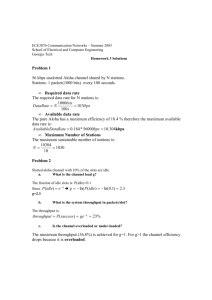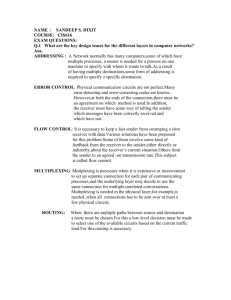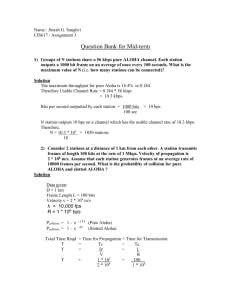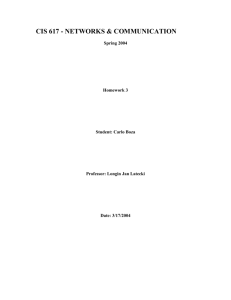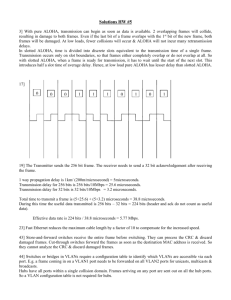Understanding Spatio-Temporal Uncertainty in Medium Access with
advertisement
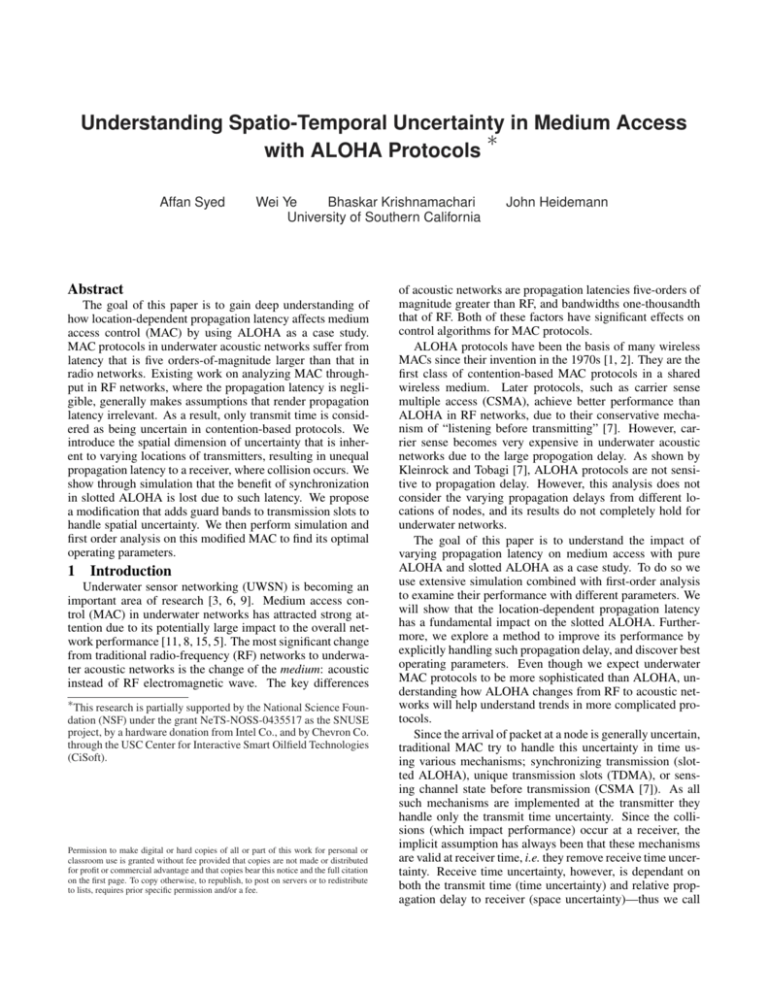
Understanding Spatio-Temporal Uncertainty in Medium Access ∗ with ALOHA Protocols Affan Syed Wei Ye Bhaskar Krishnamachari University of Southern California Abstract The goal of this paper is to gain deep understanding of how location-dependent propagation latency affects medium access control (MAC) by using ALOHA as a case study. MAC protocols in underwater acoustic networks suffer from latency that is five orders-of-magnitude larger than that in radio networks. Existing work on analyzing MAC throughput in RF networks, where the propagation latency is negligible, generally makes assumptions that render propagation latency irrelevant. As a result, only transmit time is considered as being uncertain in contention-based protocols. We introduce the spatial dimension of uncertainty that is inherent to varying locations of transmitters, resulting in unequal propagation latency to a receiver, where collision occurs. We show through simulation that the benefit of synchronization in slotted ALOHA is lost due to such latency. We propose a modification that adds guard bands to transmission slots to handle spatial uncertainty. We then perform simulation and first order analysis on this modified MAC to find its optimal operating parameters. 1 Introduction Underwater sensor networking (UWSN) is becoming an important area of research [3, 6, 9]. Medium access control (MAC) in underwater networks has attracted strong attention due to its potentially large impact to the overall network performance [11, 8, 15, 5]. The most significant change from traditional radio-frequency (RF) networks to underwater acoustic networks is the change of the medium: acoustic instead of RF electromagnetic wave. The key differences ∗This research is partially supported by the National Science Foundation (NSF) under the grant NeTS-NOSS-0435517 as the SNUSE project, by a hardware donation from Intel Co., and by Chevron Co. through the USC Center for Interactive Smart Oilfield Technologies (CiSoft). Permission to make digital or hard copies of all or part of this work for personal or classroom use is granted without fee provided that copies are not made or distributed for profit or commercial advantage and that copies bear this notice and the full citation on the first page. To copy otherwise, to republish, to post on servers or to redistribute to lists, requires prior specific permission and/or a fee. John Heidemann of acoustic networks are propagation latencies five-orders of magnitude greater than RF, and bandwidths one-thousandth that of RF. Both of these factors have significant effects on control algorithms for MAC protocols. ALOHA protocols have been the basis of many wireless MACs since their invention in the 1970s [1, 2]. They are the first class of contention-based MAC protocols in a shared wireless medium. Later protocols, such as carrier sense multiple access (CSMA), achieve better performance than ALOHA in RF networks, due to their conservative mechanism of “listening before transmitting” [7]. However, carrier sense becomes very expensive in underwater acoustic networks due to the large propogation delay. As shown by Kleinrock and Tobagi [7], ALOHA protocols are not sensitive to propagation delay. However, this analysis does not consider the varying propagation delays from different locations of nodes, and its results do not completely hold for underwater networks. The goal of this paper is to understand the impact of varying propagation latency on medium access with pure ALOHA and slotted ALOHA as a case study. To do so we use extensive simulation combined with first-order analysis to examine their performance with different parameters. We will show that the location-dependent propagation latency has a fundamental impact on the slotted ALOHA. Furthermore, we explore a method to improve its performance by explicitly handling such propagation delay, and discover best operating parameters. Even though we expect underwater MAC protocols to be more sophisticated than ALOHA, understanding how ALOHA changes from RF to acoustic networks will help understand trends in more complicated protocols. Since the arrival of packet at a node is generally uncertain, traditional MAC try to handle this uncertainty in time using various mechanisms; synchronizing transmission (slotted ALOHA), unique transmission slots (TDMA), or sensing channel state before transmission (CSMA [7]). As all such mechanisms are implemented at the transmitter they handle only the transmit time uncertainty. Since the collisions (which impact performance) occur at a receiver, the implicit assumption has always been that these mechanisms are valid at receiver time, i.e. they remove receive time uncertainty. Receive time uncertainty, however, is dependant on both the transmit time (time uncertainty) and relative propagation delay to receiver (space uncertainty)—thus we call it space-time uncertainty [12]. We will show, using extensive simulations, that time uncertainty needs to be handled by synchronization while space uncertainty needs additional wait time (guard bands) proportional to the propagation delays. Furthermore, at least for ALOHA and potentially for other MACs, taking care of just one dimension of uncertainty does not provide any benefit. The contribution of this paper is threefold. First, we contribute to an increased understanding of the impact of large and varying propagation delays on medium access in UWSN, and illustrate this impact using ALOHA as a case study. Second, we explore how this uncertainty due to propagation delay can be handled. We propose to add guard bands to transmission slots that maintain the benefit of overlapping packets in single slots at the receiver. Finally, we explore the best operating point for these modified ALOHA and make recommendation based on extensive simulation results and first order analysis. 2 Related Work Recently there has been significant amount of work in designing underwater MAC protocols [11, 8, 12, 10, 13, 15, 5]. This paper however does not attempt to design a new MAC protocol; it attempts to understand and explore the fundamental aspects of medium access that change for the new acoustic medium and propose a framework for analyzing the performance of MAC protocols. Vieira et al. [13] performed simple analysis of slotted ALOHA in underwater networks and reached a conclusion similar to our: slotted ALOHA degrades to pure ALOHA under high latency. However they did not propose a mechanism to handle this degradation, as we do after we were able to identify the cause of this degradation. Xie et al. [15] have compared the performance of ALOHA and CSMA with RTS/CTS mechanism for underwater networks. Gibson et al. [5] have extended this work to analyze the performance of ALOHA in a linear multi-hop topology. These papers, however do not attempt to address the following questions: why ALOHA’s performance remains same as in RF? why slotted ALOHA’s performance degrades to pure ALOHA with any propagation delay? How can this degradation be handled and what are the optimal parameters for it? In this paper we specifically address these questions and provide answers. 3 Spatio-temporal Uncertainty in Medium Access In this section we summarize the concept of space-time uncertainty with regards to medium access, first introduced in a prior work [12]. We then explain the methodology with which we examine its impact on MAC protocols and also the proposed modifications that attempt to remove this uncertainty. 3.1 Space-Time Uncertainty Space-time uncertainty, defined as the two dimensional uncertainty in determining a collision at a particular receiver, is a direct consequence of both the packet transmit time and the propagation latency from transmitters at different locations. Traditional analysis considers only the transmit time uncertainty and assumes equidistant receiver, which directly maps the collision at a receiver to the transmit time at all (a) Same transmission time; no (b) Different transmission collision at B time but collision at B Figure 1. Illustration of space-time uncertainty transmitters [7]. Although with an ad hoc network, a receiver cannot be guaranteed to be equidistant to all transmitters, this assumption does not introduce significant errors in RF networks, as the progation latency is very small. However, in underwater networks, we need to consider the packet arrival time at the receiver, which is dependant on both the location of transmitters and their transmit times. This space-time uncertainty can also be viewed as a duality where similar collision scenarios can be constructed by varying either the transmission times or the locations of nodes. Figure 1 illustrates the space-time uncertainty. In Figure 1(a), both nodes A and E transmit packets at the same time. However, instead of causing a collision, both packets are separately received at node B, due to their different arrival times at B. Since classical analysis only considers time uncertainty, it will incorrectly assume that there is a collision. On the other hand, when nodes A and E transmit at different instants, as shown in Figure 1(b), their packets still overlap at B due to their different propagation delays to B. In this case, classical analysis will assume no collision based on different transmit times. Therefore, when only time uncertainty is considered, the assumption on collision is wrong for both cases. The duality view of space-time uncertainty is that a collision at B could also have occurred if node D transmitted at a later time than node E. Although, in principle, this uncertainty occurs in all communication, it is only significant in acoustic communication where latency is very large, as we will show in Section 4.2.1. The lesson from understanding this two dimensional uncertainty is that we have to take care of both dimensions to obtain guarantees similar to that in handling transmission time in RF networks. As in slotted ALOHA, time synchronization removes the uncertainty in transmit time. We further postulate that adding guard bands to slots (proportional to propagation delay) after transmission helps in reducing the uncertainty due to propagation delay. Larger guard bands increase per packet latency, thus reducing throughput, but also help in decreasing the collision probability at receivers. We explore this tradeoff in greater detail when we propose a modification to slotted ALOHA in Section 5.1. 3.2 Evaluation Methodology In order to evaluate the impact of the space-time uncertainty explained above, we consider ALOHA protocols as a case study. We examine their performance with extensive simulation and first-order analysis. ALOHA protocols are the simplest and earliest wireless MAC protocols, allow- 4 Understanding with ALOHA Space-Time Uncertainty The purpose of this section is to understand how time uncertainty is dealt with in classical analysis and how the introduction of space uncertainty affects these results. As described in Section 3.2, we consider ALOHA protocols as a case study for this purpose. We first look at classical analysis of ALOHA protocols that considers only time uncertainty, then introduce pairwise latency to understand the impact of space uncertainty. 4.1 Analysis of ALOHA with Time Uncertainty We first refresh the classical analysis of the simple, or pure ALOHA protocol [4]. where nodes immediately transmit arriving application packets. This analysis is centered at the transmitter and thus only considers time uncertainty. It makes a simplified assumption that all nodes are equidistant to a single receiver, mapping the similar collision scenario from the receiver to the transmitter. It further assumes that there are infinite numbers of nodes, which implies that all Poisson arriving packets are served immediately at different nodes and thus being offered immediately to the network. Vulnerability Interval Tim e V ulnerability Interval 2T T D ata Time Data S lot 0 T (a) Aloha T S lot 1 (b) Slotted ALOHA Figure 2. Vulnerability intervals for ALOHA and slotted ALOHA. 0.5 Normalized Throughput ing easy analysis. Just as understanding ALOHA helps in understanding more complex wireless (RF) MAC protocols by providing a framework, we expect our work to be helpful in larger efforts to understand more complex underwater MACs. We run simulations on a custom-built, packet-level simulator designed for UWSN MAC research [12]. Our simulation scenario consists of a single receiver that does not transmit, with nodes randomly deployed in a circular region with a radius equal to the maximum propagation delay. Nodes, with a single packet buffer, transmit based on an offered load to the network modeled as a Poisson process, with mean ranging from 0 to 3 packets/transmission time, and we only observe the packets successfully received at our designated receiver. We choose a single receiver to parallel our analysis of protocol behavior, but have verified that our results hold with packets reception at other nodes in the network. Protocol performance is evaluated through the normalized throughput (to the channel bandwidth). Simulations are run with 32 nodes (unless otherwise noted), representing a reasonable approximation to the infinite node assumption made in classical analysis for the offered load that we consider. Each simulation data point is the averaged result of 25 simulation runs with error bars showing 95% confidence intervals. Our simulator is general enough for different propagation speed in different media (acoustic and RF). To accommodate different transmission ranges and propagation delays, we utilize a normalizing parameter a, defined as the ratio of maximum propagation delay to packet transmission time T (the same definition used by Klienrock and Tobagi [7]). This parameter allows us to investigate the impact of propagation delay without concentrating on a single network deployment. We use a packet length of 1sec (1Kbytes for acoustic modem at 1Kbytes/s), assume speed of sound as 1500m/s and alter the maximum range to simulate different delay regimes. 0.4 Slotted ALOHA 0.3 0.2 ALOHA 0.1 0 0 0.5 1 1.5 2 2.5 3 3.5 4 Offered Load G (packets/transmit time) Figure 3. Classical throughput analysis for ALOHA. The packets that collide are buffered and retransmitted after an exponential delay. The total offered load to the network is thus combination of the Poisson arrival and exponential retransmissions, and is a Poisson process with parameter G. The vulnerability interval (VI) is defined as the time interval relative to a sender’s transmission within which another node’s transmission causes collision [7]. Assuming T as the packet transmission time, Figure 2(a) shows that the VI is equal to 2T. Without going into the details, if we normalize T to unit time, the throughput of ALOHA becomes [4]: TH ALOHA = G e−2G (1) Slotted ALOHA allows transmission only at the start of synchronized slots of length T . As Figure 2(b) shows, this synchronization ensures that only interfering packets that arrive in slot 0 will result in a collision. It thus reduces the VI from 2T to T by preventing any cross slot overlapping. The throughput of slotted ALOHA is thus increased as [4]: TH slotted ALOHA = G e−G (2) The analytical results for both protocols is shown in Figure 3, as a reproduction from several early works [4, 7]. Slotted ALOHA achieves maximum normalized throughput of 36.8% at a G of 1 packet/transmit time, while simple ALOHA achieves it maximum of 18.4% at 0.5 packets/transmit time. As mentioned above, this analysis is carried out with respect to the transmitter’s time. The assumption of a single receiver that is equidistant to all transmitters will result in a=0.01 a=0.5 a=1 a=0.01 a=0.5 a=1 0.5 Normalized Throughput Normalized Throughput 0.5 0.4 0.3 0.2 0.1 0 0.4 0.3 0.2 0.1 0 0.5 1 1.5 2 2.5 3 0 0 Offered Load G (packets/transmit time) Figure 4. Throughput of pure ALOHA is not affected by propagation delay. a similar vulnerability interval at the receiver—regardless of the propagation delay (as shown by Klienrock and Tobagi [7]). Strictly speaking, these assumptions do not hold for all ad hoc wireless networks, but with short-range RF networks the variation in delay is small enough that it has virtually no effect on performance (for example, 10µs delay over 25m). In satellite networks delay is long, but there is typically only one sender or receiver. We next show, through extensive simulation, that the performance of ALOHA can be significantly affected in acoustic networks where these assumptions do not hold. 4.2 ALOHA with Space Uncertainty In order to understand the impact of location-dependent propagation latency, we now evaluate both simple ALOHA and slotted ALOHA using simulation setup explained in Section 3.2. All nodes have a single packet buffer and the offered load varies as the number of packets offered to the network per packet transmit time T . 4.2.1 Simple ALOHA We first evaluate how the throughput of pure ALOHA is affected by different values of a. Figure 4 shows the simulation results. We can see that the normalized throughput achieved by simple ALOHA remains the same as when no propagation delay is considered, even under different delay regimes. To understand this, we need to look at it from the receiver’s perspective in both scenarios: with and without propagation delay. With no propagation delay and packets being transmitted as soon as they arrive, they reach the receiver instantaneously with exactly the same Poisson distribution. Hence the analysis at the transmitter faithfully reflects the situation at the receiver. With different node locations, the arrival time at the receiver will be offset by a constant delay for any transmitter in a particular topology. However, such arrival at the receiver is still a Poisson process with the same parameter as when there is no latency. Therefore, from the receiver’s perspective, there is no change in probability of collision, and thus the throughput performance is the same as that in Figure 3. We should point 0.5 1 1.5 2 2.5 3 Offered Load G (packets/transmit time) Figure 5. Throughput of slotted ALOHA degrades with any propagation latency. Global slot 0 Global slot 1 Global slot 2 A Data Time T Distance A’s Data R B VI=2T Figure 6. Slotted transmission results in cross slots overlap at receiver. out that simple ALOHA does not even handle time uncertainty, hence further ignoring space uncertainty has no impact due to their duality. 4.2.2 Slotted ALOHA Next we evaluate how slotted ALOHA performs in different delay regimes. Slotted ALOHA does handle one dimension (time) of uncertainty by synchronizing transmission slots. Since it does not take care of the space uncertainty, our initial intuition is that the impact of this uncertainty will increase with larger values of a. As shown by simulation results in Figure 5, the throughput of slotted ALOHA does degrade to a level similar to simple ALOHA when propagation latency is considered. (A similar observation is made by Vieira et al. [13]). What is more interesting, however, is that such degradation occurs immediately with any propgation delay even when it is very small (a=0.01). In order to understand this, we look at how the globally synchronized transmission slots overlap at a receiver. Figure 6 shows how the packets transmitted in transmission slots of nodes A and B overlap at the receiver R. Node G lobal slot w ith guard bands ßt m ax A 0.5 Tim e T D istance R A ’s D ata B Normalized Throughput D ata 0.4 fraction=1 0.3 fraction=0.5 0.2 fraction=0.1 0.1 0 Figure 7. Slotted ALOHA with guard bands. 0 0.5 1 1.5 2 2.5 3 Offered Load G (packets/transmit time) (a) a=0.1 5 Handling Space Uncertainty We now postulate that space uncertainty can be handled by the addition of extra guard bands beyond T in slots. These guard bands are added to ensure that the original single slot overlap is maintained at the receiver. We also look at the optimal length of these guard bands in relation to the propagation delays. Finally we also illustrate that if space uncertainty is handled in this way without synchronizing transmit time (which handles time uncertainty), we do not achieve any benefit. 5.1 Slotted ALOHA with Guard Bands In our modification to slotted ALOHA, nodes still transmit only at the start of globally synchronized slots. The 0.5 Normalized Throughput A’s transmission in slot 1 can collide with any packet transmitted by node B in slot 1 (arrived at B during slot 0) and any one transmitted in slot 2 (arrived at B during slot 1). As long as node A and B are not equidistant to the receiver (or the difference in their propagation delays is an exact multiple of T ), either node’s transmission can collide with the other’s due to a packet arrival during a vulnerability interval of 2T . This is the same vulnerability interval as in simple ALOHA, and thus any propagation latency to the receiver completely losses the benefit of time synchronization. If the network always has a single receiver, and nodes knew their relative locations, it is conceivable for slotting to be made relative to the receiver. However this simplification does not match the ad hoc network paradigm where any node can be a potential receiver. Radio networks, although having very small propagation latency, do undergo a similar performance degradation, as we model any packet overlap as collision. However, most RF systems can usually tolerate an overlap of up to a single bit (depending on coding techniques). As a result for high speed RF networks, if bit rate is 10Mb/s (e.g., IEEE 802.11b), the maximum propagation delay that slotted ALOHA can tolerate is 1ns, or 30m in distance. Thus such systems do not exhibit the immediate performance degradation that we have shown for any propagation delay. On the other hand, acoustic systems even with low data rate modems (1Kb/s [14]) can tolerate only 1ms or 1.5m in distance due to much slower speed of propagation (about 1500m/s). Thus the impact of spatial uncertainty for slotted ALOHA will be more evident for any acoustic network than it is for RF networks. 0.4 0.3 0.2 fraction=0.5 fraction=0.1 0.1 0 fraction=1 0 0.5 1 1.5 2 2.5 3 Offered Load G (packets/transmit time) (b) a=1.2 Figure 8. Slotted ALOHA with guard bands slot duration, however, is increased from T to T + β · τmax , where β represents the fraction of maximum propagation delay (τmax ) that nodes wait after finishing their transmission (Figure 7). Choosing β = 1 ensures that no overlap at the receiver occurs unless packets are transmitted in the same slot, the guarantee that slotted ALOHA was originally designed to achieve when delay is not important. However this results in a long wait time after each packet that will increase packet transmission latency and bandwidth overhead. With β < 1 there remains the possibility that some node pairs still have the vulnerability interval of two slot durations (as in Figure 6). Therefore, reducing β value lowers the bandwidth overhead, but increases collision probability. Based on the intuition that the distance between node pairs is often smaller than the maximum propagation delay, we vary β to evaluate the tradeoff between bandwidth overhead and collision probability. Figure 8 shows the simulation results of slotted ALOHA with guard bands at two different delay regimes. We can make three interesting observations from these results. First, using guard bands allows slotted ALOHA to regain a fraction of its lost throughput. Changing the value of β shifts the throughput between that of slotted ALOHA with on delay (maximum throughput of 36.8% at G=1) and simple 0.5 0.5 0.45 0.45 Slotted ALOHA (no delay) 0.35 a=0.1 a=0.5 0.3 0.25 a=1 0.2 a=2 0.15 Slotted ALOHA (no delay) 0.4 a=0.01 Normalized Throughput Normalized Throughput 0.4 β =1 0.35 0.3 β =0.3 0.25 β =0.5 β =0.1 0.2 0.15 Pure ALOHA 0.1 0.1 Pure ALOHA 0.05 0.05 0 0 0.1 0.2 0.3 0.4 0.5 0.6 0.7 Guard band fraction β 0.8 0.9 0 1 0 0.2 0.4 0.6 0.8 1 1.2 1.4 1.6 1.8 2 a (propagation delay/transmit time) Figure 9. Effect of choosing β length guard bands on throughput capacity Figure 10. Effect of propagation delay on throughput capacity ALOHA (maximum throughput of 18.4% at G=0.5) as in Figure 8(a). Second, the level of improvement is dependant on the choice of β and the propagation delay regime a. With a=0.1 (Figure 8(a)) the best curve is within 5% of the performance of slotted ALOHA with no delay, but for a=1.2 (Figure 8(b)) the best curve is within 45%. Finally, the choice of optimal β depends upon a. For a=0.1 (Figure 8(a)), the maximum throughput is achieved at β=1; for a=1.2 (Figure 8(b)) however the optimal β is 0.5. In order to further investigate the parameters β and a, we next look at their individual impact on throughput. 5.1.2 5.1.1 Impact of Varying Guard Band Length We now look at the maximum achievable throughput, or throughput capacity, that slotted ALOHA can achieve (at an optimal offered load) for a particular value of guard band expressed as a fraction (β) of the maximum propagation delay. Figure 9 shows the results for several different values of a. We can make several observation from this result. First, higher throughput can be achieved using guard bands for lower values of a. This indicates the benefit of short-range communication and long packet duration. For example, assume we use an acoustic modem that has a communication range of 300m and a speed of 1Kb/s [14]. If we use packet length of 250 bytes, a will be 0.1, and the modified slotted ALOHA can achieve performance similar to the slotted ALOHA in RF networks. Second, the guard band seldom has to be the maximum propagation delay. A value around 0.5–0.6 gives the throughput that is very close to the best value. Reducing guard band from 1 to 0.5 may largely affect latency. For example, at low loads, the latency can be reduced by half. Finally, for any value of a beyond 1, the benefit of choosing guard band diminishes. For example, with the modem of 1kb/s and the communication range of 300m, the packet length should be larger than 25 bytes (or 200 bits) for visible benefit of using guard bands. Impact of Varying Maximum Delay We next vary a to observe how the the throughput capacity is affected by propagation delay in slotted ALOHA modified with guard bands. We want to generate a figure that is similar to Figure 10 in the paper by Klienrock and Tobagi regarding the impact of propagation delay on throughput capacity for different flavors of CSMA [7]. However, due to their equidistant and single receiver assumption they show that the capacity of slotted ALOHA is not affected by latency, which we have shown to be incorrect for general ad hoc networks in Section 4.2.2. Figure 10 shows the throughput capacity for different values of β as we vary the propagation delay. First we observe that beyond βa=1, using different guard bands does not increase the capacity, in fact for certain values of β the capacity is even lower than just using simple ALOHA (as we saw for a=1.2 in Figure 10 when β=1). This is because beyond βa=1 the decrease in probability of collision provided by additional guard bands become constant, while the overhead continues to increase and thus the capacity will only get worse beyond this regime. Furthermore, β = 0.5 seems to be a good choice over the range of a[0,1] as it gives good capacity at lower values of a while not degrading to below simple ALOHA at a=1. 5.1.3 Analysis of ALOHA with Guard Bands We summarize briefly results from a mathematical analysis of the throughput of our modified ALOHA with respect to key parameters. Consider a scenario with a single receiver and n nodes are randomly deployed in a circular region around it. Assume a normalize packet length of 1 second, so that the radius is a constant c (speed of propagation) times a. The pdf of any given node being distance r from the receiver is given thus as: pdf(r) = 2 ·r (c · a)2 (3) Our analysis is simplified by assuming a Bernoulli arrival process for the n nodes, i.e. each transmits a packet with probability p in a given slot. For large n and low p the results will be similar to the Poisson arrival process that we employed in our simulations. We can derive the expected throughput (S) for n nodes to be: E[number of collision-free packets received per slot] S(p, β, a) = 1 + βa (4) The main result of our analysis is the following proposition: Proposition 1 Assume that a > 0 and βa ≤ 1. The expected number of collision-free packets per slot can be represented by a function g(β, p) that is independent of a. As a Offered Load G (packets/transmit time) result the maximum achievable throughput S∗ can be defined Figure 11. Throughput performance for unsynchronized as a function of of β and a as follows: slotted ALOHA. f (β) S∗ (β, a) = (5) 1 + βa of uncertainty (time dimension), this modified version of Where f (β) is defined as the maximum collision probALOHA attempts to handle just the space dimension of unability over all arrival rates p. We omit the details of the certainty. Similarly, the simple ALOHA with guard bands proof here due to space constraints, but the core result in this fails to perform better due to the duality of space and time. proposition, the independence of the numerator term from Therefore, to improve the performance of ALOHA, the una, can BE shown essentially by considering different regions certainty in both time and space must be handled simultanebased on whether packet reception can span slot boundaries, nously. and then applying a scaling argument. Equation 5 allows ∗ 6 Future Work us to make two important inferences about S (β, a) that also corroborate our simulation results in Figure 9 and 10. This is our initial work in understanding the impact of The first inference is that if β is fixed, then the maximum large, location-dependent latency on MAC protocols in un1 derwater acoustic networks. We plan to rigorously analyze throughput S∗ (β, a) will go down as 1+βa as we vary a. Equathe throughput capacity of our modified slotted ALOHA tion 5 predicts that for β = 0.5 and β = 1, the maximum while removing the assumption regarding single and equidisvalue of throughput at a = 1 will be 2/3 and 1/2 of its value, tant receiver made in classical analysis. We also want to obrespectively, at a=ε. Figure 10 corroborates this (we choose serve the impact of choosing different guard bands on the ε=0.01); for β = 0.5 a = 1 the throughput is 21.9% approxilatency and thus make an even stronger recommendation for mately 2/3 of the maximum throughput of 32.3% at a = 0.01. choosing parameters. We hope that this analysis will proSimilarly for β = 1 a = 1 the throughput is 18.6% again apvide a framework to analyze other wireless protocols (e.g. proximately 1/2 of the maximum throughput of 37.6% at CSMA) with delay considerations and increase our undera = 0.01. In fact when a=ε, S∗ (β, a) can be approximated standing of the fundamental characteristics of medium acas f (β) and so we can observe this function in our numerical cess in UWSN. The impetus for this research arises in the results for a=0.01 in Figure 9. development of an underwater MAC and some of the core It can also be deduced from the proposition that if there design principals developed thereof [12]. exists some a∗ for which maximum throughput S∗ (β, a) increases monotonically with respect to β, then it will increase 7 Conclusions monotonically for all a ≤ a∗ . This inference is also corrobIn this paper we have explored the impact of spatioorated by Figure 9, where we see all curves below a=0.5 temporal uncertainty that exists regarding packet reception (which increases monotonically with β) exhibiting this propin underwater networks. We have shown that without conerty. sidering location-dependant propagation latency that intro5.2 Simple ALOHA with Guard Bands duces the spatial dimension of uncertainty, protocols such Since in the previous section we have observed that as slotted ALOHA are significantly affected. Adding guard adding guard bands to slotted ALOHA takes care of space bands to transmission slots provides an ability to counter this uncertainty, we decided to explore if adding guard bands to spatial uncertainty. We have also shown that it is necessary simple ALOHA would provide any benefit. Our modificato consider both space and time uncertainty while designing tion to simple ALOHA results in nodes forming local unsynMAC protocols under high latency environment of acoustic chronized slots, where they transmit only at the beginning of UWSN. Furthermore we have shown that smaller ratio of their slots which posses additional guard bands. propagation delay to packet length result gives better insulaHowever, as Figure 11 shows, simply adding guard bands tion to the impact of spatial uncertainty. The results demonwithout slot synchronization are unable to provide any benstrate the benefit of short-range communication, where it efit in throughput. The reason is that just as slotted ALOHA is possible for our modifed slotted ALOHA to achieve the without any guard bands takes care of just one dimension throughput that is similar to slotted ALOHA in RF networks. a=1 a=0.1 a=0.01 Normalized Throughput 0.5 0.4 0.3 0.2 0.1 0 0 0.5 1 1.5 2 2.5 3 8 References [1] Norman Abramson. The ALOHA system. In Proceedings of AFIPS 1970 Fall Joint Computer Conference, volume 37, pages 281–285, 1970. [2] Norman Abramson. Development of the ALOHANET. IEEE Transactions on Information Theory, 31(2):119– 123, March 1985. [3] Ian F. Akyildiz, Dario Pompili, and Tommaso Melodia. Underwater acoustic sensor networks: research challenges. Ad Hoc Networks Journal, pages 257–279, march 2005. [4] Dimitri Bertsekas and Robert Gallager. Data Networks. Prentice Hall, second edition, 1996. [5] John H. Gibson, Geoffrey G. Xie, Yang Xiao, and Hui Chen. Analyzing the performance of multi-hop underwater acoustic sensor networks. In Proceedings of the MTS/IEEE OCEANS Conference, Aberdeen, Scotland, June 2007. [6] John Heidemann, Yuan Li, Affan Syed, Jack Wills, and Wei Ye. Underwater sensor networking: Research challenges and potential applications. In Proceedings of the IEEE Wireless Communications and Networking Conference, Las Vegas, Nevad, USA, April 2006. [7] Leonard Kleinrock and Fouad Tobagi. Packet switching in radio channels: Part I - carrier sense multiple access modes and their throughput delay characteristics. IEEE Transactions on Computing, 23(12):1400–1416, December 1975. [8] Marcal Molins and Milica Stojanovic. Slotted fama: A mac protocol for underwater acoustic networks. In Proceedings of the IEEE OCEANS’06 Asia Conference, Singapore, May 2006. [9] Jim Partan, Jim Kurose, and Brian Neil Levine. A survey of practical issues in underwater networks. In WUWNet ’06: Proceedings of the 1st ACM international workshop on Underwater networks, pages 17– 24, New York, NY, USA, 2006. ACM Press. [10] Borja Peleato and Milica Stojanovic. A mac protocol for ad-hoc underwater acoustic sensor networks. In WUWNet ’06: Proceedings of the 1st ACM international workshop on Underwater networks, pages 113– 115, New York, NY, USA, 2006. ACM Press. [11] Volkan Rodoplu and Min Kyoung Park. An energyefficient mac protocol for underwater wireless acoustic networks. In Proceedings of the MTS/IEEE OCEANS’05 Conference, Washington DC, USA, September 2005. [12] Affan A. Syed, Wei Ye, and John Heidemann. T-Lohi: A new class of MAC protocols for underwater acoustic sensor networks. Technical Report ISI-TR-638, USC/Information Sciences Institute, April 2007. [13] Luiz Filipe M. Vieira, Jiejun Kong, Uichin Lee, and Mario Gerla. Analysis of aloha protocols for underwater acoustic sensor networks. Extended abstract in WUWNet ’06 Los Angeles, CA, USA, 2006. [14] Jack Wills, Wei Ye, and John Heidemann. Low-power acoustic modem for dense underwater sensor networks. In Proceedings of the First ACM International Workshop on UnderWater Networks (WUWNet), page to ap- pear, Los Angeles, California, USA, September 2006. ACM. [15] Peng Xie and Jun-Hong Cui. Exploring random access and handshaking techniques in large-scale underwater wireless acoustic sensor networks. In Proceedings of the MTS/IEEE OCEANS Conference, Boston, Massachusetts, September 2006.
